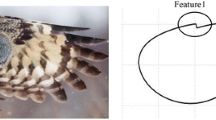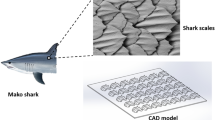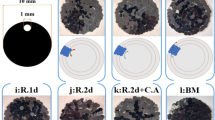Abstract
Windbreak fences in open and urban areas can be used to effectively reduce the wind velocity. In this paper we examine how the geometrical shape of the windbreak fence can optimally mitigate wind velocity. We propose an approach for windbreak fence design based on a bionic parametric model of the shark skin denticle geometry, which improves the reduction of the wind velocity around and behind the windbreak fences. The generative model was used to estimate improvements by variations in the parameters of the fence panel’s geometrical shape, inspired by shark skin denticles. The results of the Computational Fluid Dynamics (CFD) analysis indicates that the fence surface inspired by shark skin performs much better than both flat and corrugated surfaces. Taking into account the complex geometry of the surface inspired by shark skin denticles, we propose a fabrication process using an expanded polystyrene foam (EPS) material, created using an industrial robot arm with a hot-wire tool. Creating EPS moulds for the shark skin denticle panels allows for a richer variety material to be used in the final design, leading both to higher efficiency and a more attractive design.
Similar content being viewed by others
References
Dean B, Bhushan B. Shark-skin surfaces for fluid-drag reduction in turbulent flow: A review. Philosophical Transactions of the Royal Society of London A: Mathematical, Physical and Engineering Sciences, 2010, 368, 4775–4806.
Shu L H, Ueda K, Chiu I, Cheong H. Biologically inspired design. CIRP Annals-Manufacturing Technology, 2011, 60, 673–693.
Bixler G D, Bhushan B. Shark skin inspired low-drag microstructured surfaces in closed channel flow. Journal of Colloid and Interface Science, 2013, 393, 384–396.
Martin S, Bhushan B. Modeling and optimization of shark-inspired riblet geometries for low drag applications. Journal of Colloid and Interface Science, 2016, 474, 206–215.
Feng L, Li S, Li Y, Li H, Zhang L, Zhai J, Song Y, Liu B, Jiang L, Zhu D. Super-hydrophobic surfaces: From natural to artificial. Advanced Materials, 2002, 14, 1857–1860.
Bhushan B, Jung Y C. Micro-and nanoscale characterization of hydrophobic and hydrophilic leaf surfaces. Nanotechnology, 2006, 17, 2758–2772.
Malshe A, Rajurkar K, Samant A, Hansen H N, Bapat S, Jiang W. Bio-inspired functional surfaces for advanced applications. CIRP Annals-Manufacturing Technology, 2013, 62, 607–628.
Reichert S, Menges A, Correa D. Meteorosensitive architecture: Biomimetic building skins based on materially embedded and hygroscopically enabled responsiveness. Computer Aided Design, 2015, 60, 50–69.
Duro-Royo J, Zolotovsky K, Mogas-Soldevila L, Varshney S, Oxman N, Boyce M C, Ortiz C. MetaMesh: A hierarchical computational model for design and fabrication of biomimetic armored surfaces. Computer Aided Design, 2015, 60, 14–27.
Han Z, Mu Z, Yin W, Li W, Niu S, Zhang J, Ren L. Biomimetic multifunctional surfaces inspired from animals. Advances in Colloid and Interface Science, 2016, 234, 27–50.
Zhao D, Tian Q, Wang M, ** Y. Study on the hydrophobic property of shark-skin-inspired micro-riblets. Journal of Bionic Engineering, 2014, 11, 296–302.
Reichert S, Schwinn T, La Magna R, Waimer F, Knippers J, Menges A. Fibrous structures: an integrative approach to design computation, simulation and fabrication for lightweight, glass and carbon fibre composite structures in architecture based on biomimetic design principles. Computer Aided Design, 2014, 52, 27–39.
Letchford C W, Lander D C, Case P, Dyson A, Amitay M. Bio-mimicry inspired tall buildings: The response of cactus- like buildings to wind action at Reynolds Number of 104. Journal of Wind Engineering and Industrial Aerodynamics, 2016, 150, 22–30.
Hu N, Feng P, Dai G. The gift from nature: bio-inspired strategy for develo** innovative bridges. Journal of Bionic Engineering, 2013, 10, 405–414.
Steinbuch R. Bionic optimisation of the earthquake resistance of high buildings by tuned mass dampers. Journal of Bionic Engineering, 2011, 8, 335–344.
Dong Z, Luo W, Qian G, Lu P, Wang H. A wind tunnel simulation of the turbulence fields behind upright porous wind fences. Journal of Arid Environments, 2010, 74, 193–207.
Speckart S O, Pardyjak E R. A method for rapidly computing windbreak flow field variables. Journal of Wind Engineering and Industrial Aerodynamics, 2014, 132, 101–108.
Li W, Wang F, Bell S. Simulating the sheltering effects of windbreaks in urban outdoor open space. Journal of Wind Engineering and Industrial Aerodynamics, 2007, 95, 533–549.
Santiago J L, Martin F, Cuerva A, Bezdenejnykh N, Sanz-Andres A. Experimental and numerical study of wind flow behind windbreaks. Atmospheric Environment, 2007, 41, 6406–6420.
Cong X C, Du H B, Peng S T, Dai M X. Field measurements of shelter efficacy for installed wind fences in the open coal yard. Journal of Wind Engineering and Industrial Aerodynamics, 2013, 117, 18–24.
Li B, Sherman D J. Aerodynamics and morphodynamics of sand fences: A review. Aeolian Research, 2015, 17, 33–48.
Kim H B, Lee S J. The structure of turbulent shear flow around a two-dimensional porous fence having a bottom gap. Journal of Fluids and Structures, 2002, 16, 317–329.
Rosenfeld M, Marom G, Bitan A. Numerical simulation of the airflow across trees in a windbreak. Boundary-Layer Meteorology, 2010, 135, 89–107.
Bourdin P, Wilson J D. Windbreak aerodynamics: Is computational fluid dynamics reliable? Boundary-layer meteorology, 2008, 126, 181–208.
Bitog J P, Lee I B, Shin M H, Hong S W, Hwang H S, Seo I H, Yoo J I, Kwon K S, Kim Y H, Han J W. Numerical simulation of an array of fences in Saemangeum reclaimed land. Atmospheric Environment, 2009, 43, 4612–4621.
Chen G, Wang W, Sun C, Li J. 3D numerical simulation of wind flow behind a new porous fence. Powder Technology, 2012, 230, 118–126.
Hong S W, Lee I B, Seo I H. Modelling and predicting wind velocity patterns for windbreak fence design. Journal of Wind Engineering and Industrial Aerodynamics, 2015, 142, 53–64.
Kumar P, Feiz A A, Ngae P, Singh S K, Issartel J P. CFD simulation of short-range plume dispersion from a point release in an urban like environment. Atmospheric Environment, 2015, 122, 645–656.
Franke J, Hellsten A, Schlunzen H A, Carissimo B. The Best Practise Guideline for the CFD simulation of flows in the urban environment: An outcome of COST 732. The Fifth International Symposium on Computational Wind Engineering, Chapel Hill, North Carolina, USA, 2010.
Tominaga Y, Akabayashi S I, Kitahara T, Arinami Y. Air flow around isolated gable-roof buildings with different roof pitches: Wind tunnel experiments and CFD simulations. Building and Environment, 2015, 84, 204–213.
Benni S, Tassinari P, Bonora F, Barbaresi A, Torreggiani D. Efficacy of greenhouse natural ventilation: Environmental monitoring and CFD simulations of a study case. Energy and Buildings, 2016, 125, 276–286.
Zhang D Y, Luo Y H, **ang L I, Chen H W. Numerical simulation and experimental study of drag-reducing surface of a real shark skin. Journal of Hydrodynamics, Ser. B, 2011, 23, 204–211.
di Perta E S, Agizza M A, Sorrentino G, Boccia L, Pindozzi S. Study of aerodynamic performances of different wind tunnel configurations and air inlet velocities, using computational fluid dynamics (CFD). Computers and Electronics in Agriculture, 2016, 125, 137–148.
Guo W, Liu X, Yuan X. A case study on optimization of building design based on CFD simulation technology of wind environment. Procedia Engineering, 2015, 121, 225–231.
Lipson H. Homemade: The future of functional rapid prototy**. IEEE Spectrum, 2005, 24–31.
Petkov K P, Hattel J H. A thermo-electro-mechanical simulation model for hot wire cutting of EPS foam. International Journal of Machine Tools and Manufacture, 2016, 107, 50–59.
Paes K, Dewulf W, Van der Elst K, Kellens K, Slaets P. Energy efficient trajectories for an industrial ABB robot. Procedia CIRP, 2014, 15, 105–110.
Author information
Authors and Affiliations
Corresponding author
Rights and permissions
About this article
Cite this article
Bajsanski, I., Stojakovic, V., Tepavcevic, B. et al. An application of the shark skin denticle geometry for windbreak fence design and fabrication. J Bionic Eng 14, 579–587 (2017). https://doi.org/10.1016/S1672-6529(16)60423-7
Published:
Issue Date:
DOI: https://doi.org/10.1016/S1672-6529(16)60423-7




